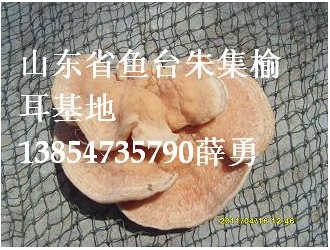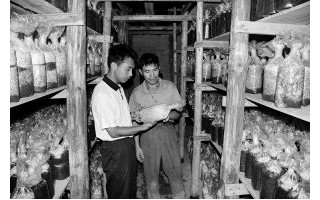中國蜜環菌的新生物種
趙俊 田淑敏 Kari KORHONEN 戴玉成 劉春如
摘 要:在調查研究蜜環菌生物種的過程中,先后在東北、華北、華中和西南地區,發現了四個新的中國蜜環菌生物種,CBSF、CBSG、CBSH和CBSI。研究表明,CBSG屬于典型的同宗配合種,其余三個為異宗配合。CBSH與CBSC之間存在部分互交可育,比例高達17.8%,在同一個國家的兩個種之間出現如此高的互交可育比例還是首次報道。上述三個生物種同歐美的已知蜜環菌種均互交不育,為亞洲特有種。CBSI為無菌環的假蜜環菌A.tabescens(Scop.)Emel,它與歐洲的假蜜環菌互交可育,屬于同種。但同中國其它各生物種互交不育。同時討論了蜜環菌生物種的群體觀點。
關鍵詞:蜜環菌,中國生物種,假蜜環菌,同宗配合,異宗配合
分類號:Q939.5 文獻標識碼:A
文章編號:1007-3515(2000)04-0509-0516
NEW BIOLOGICAL SPECIES OF ARMILLARIA IN CHINA
QIN Guo-Fu(Genaral Station of Forest Pest Control, State Forestry Administration, Shenyang, 110034, China)
ZHAO Jun(Genaral Station of Forest Pest Control, State Forestry Administration, Shenyang, 110034, China)
TIAN Shu-Min(Genaral Station of Forest Pest Control, State Forestry Administration, Shenyang, 110034, China)
KORHONEN K(Finnish Forest Research Institute,P.O.Box 18, FIN-01301, Vantaa,Finland)
DAI Yu-Cheng(Botanical Museum,University of Helsinki,P.O.Box 47, FIN-00014, Finland)
LIU Chun-Ru(Hunan Forestry College,Hengyang, 421005, China)
Abstract:Four new biological species of Armillaria in China were determined from forty basidiocarps which collected from northern and southwestern China by total 4560 pair combinations of singles spore isolates. Twelve basidiocarps were deduced sexuality: homothallism from 3 basidiocarps and heterothallism from other 9 ones. These four species was named Chinese Biological Species(CBS) F, G, H, I, repectively, and intersterile with European and North American species of Armillaria except CBS I which was compatible with European A.tabescens (Scop.) Emel completely and should be considered conspecific. CBS G is homothallic species and distributed in southern China. CBS F is heterothallic species and distributed in northeastern China mainly. CBS H are heterothallic species and partial compatible with CBS C. The seasonal and geographical information of these CBS are discussed as well.
Keywords:Armillaria, Chinese biological species of Armillaria, A.tabescens, Homothallism, Heterothallism
基金項目:國家自然科學基金(39770618),國家青年科學基金(39500001)和國家基金對外交流與合作項目(39811130581),吉林省林業廳研究課題
作者單位:趙俊(國家林業局森林病蟲害防治總站沈陽 110034)
田淑敏(國家林業局森林病蟲害防治總站沈陽 110034)
Kari KORHONEN(芬蘭國家林業研究所,P.O.Box18,FIN-01301,Vantaa,Finland)
戴玉成(芬蘭赫爾基大學植物博物館,P.O.Box47,FIN-00014,Finland)
劉春如(湖南林業專科學校,湖南衡陽,421005)
參考文獻:
[1]賀偉,秦國夫,沈瑞祥,1996。大興安嶺和長白山地區蜜環菌生物種的研究。真菌學報,15(1):9~16
[2]秦國夫,賀偉,趙俊,田淑敏,沈瑞祥,1999。中國蜜環菌生物種與北美種的交配關系。菌物系統,18(3):243~248
[3]趙俊,田淑敏,王玉玲,秦國夫,1999。蜜環菌遺傳測定的單孢分離和培養方法。微生物學通報, 26(3):207~209
[4]Anderson J B, Korhonen K, Ullrich R C, 1980. Relationships between European and North American Biological species of Armillaria mellea. Experimental Mycology , 4:87~95
[5]Anderson J B, 1982. Bifactorial heterothallism and vegetative diplody in Clitocybe tabescens. Mycologia, 74(6):911~916
[6]Banik M T, Burdsall H H, 1998. Assessment of compatibility among Armillaria cepistipes, A. sinapina,and North American biological species and , using culture morphorlogy and molecular biology. Mycologia, 90(5)798~805
[7]Brub J A, Dessureault M, Berthelay S, Guillaumin J J, 1996. Interfertility between Armillaria cepistipes and A. sinapina. Phytoprotection, 77(2)67~74
[8]Darmono T W, Burdsall H H, Volk T J, 1992. Interfertility among isolates of Armillaria tabescens North America. Sydowia, 42(2):105~116
[9]Kile G A, Guillaumin J J, Mohammed C, Watling R, 1994. Biogeography and pathology of Armillaria. Proceedings of the the Eighth International Conference on Root and Butt Rots , IUFRO, 411~436
[10]Korhonen K, 1978. Interfertility and clonal size in the Armillariella mellea complex. Karstenia, 18:31~42
[11]Morrison D J, Chu D, Johnson A L S, 1985. Species of Armillaria in British Colombia. Can J of Pl Path,7:242~246
[12]Ota Y et al., 1998. Biological species of Armillaria in Japan. Plant Dis, 82:537~543
[13]Volk T J, Burdsall H H, 1995. A nomenclatural study of Armillaria and Armillariella Species. Synopsis Fungorum 8, Fungiflora-Oslo-Norway







